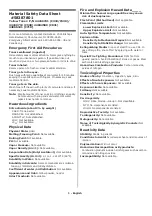
3.2 PBX PARAMETERS AND PORT SETTINGS
Installation Manual
67
3.2
PBX PARAMETERS AND PORT SETTINGS
3.2.1
General Guidelines and Definitions
Optimal performance of the VPS/PBX system relies on proper VPS programming. There are
3 categories of hardware settings: RS-232C, Port Settings, and PBX Interface Parameters.
Entering a number sets some of the parameters, while others use sequence codes.
3.2.2
RS-232C Settings
•
Baud Rate (300-38400):
Specifies the speed at which the data is transferred in bits-per-
second.
•
Word Bit Length (7-8):
Defines the number of bits in each byte or character.
•
Parity (N, O, E):
Specifies the parity used for error detection.
•
Stop Bit Length (1-2):
Specifies the number of bits used to signify the end of the byte.
•
Default:
9600, 8, N, 1
3.2.3
Port Settings
There is no need to change these in a typical installation.
Only change these parameters
when connecting the VPS to a PBX other than a KX-T series PBX. Each port on the VPS
should match the type of signaling the PBX expects. If you need to change these settings, refer
to the PBX manual or customer support office to get the correct values for these settings.
•
Flash Time—100 ms, 300 ms, 600 ms, 900
ms:
The minimum length of time that the PBX requires to recognize a hookswitch flash.
Choose the amount that is equal to or greater than the PBX’s setting.
•
CPC Signal (Calling Party Control Signal)—NONE, 6.5 ms, 150 ms, 300 ms, 450
ms, 600
ms:
The length of time allowed for the short break in loop current that is used to indicate
that the caller has hung up; usually set to NONE, since most PBXs do not provide
this signal to single line ports. If choosing a setting other than NONE, use an amount
equal to or less than the PBX or telephone company provided CPC signal.
•
Disconnect Time—1 s-8
s:
The length of time that the line is temporarily unavailable after a call has ended.
•
Dial Mode—Touchtone, Pulse 10
pps
, Pulse 20
pps
:
The type of signaling the PBX single line port expects to receive (
pps
= pulses per
second).
Summary of Contents for KX-TVS125
Page 16: ...16 Installation Manual ...
Page 17: ...Installation Manual 17 Section 1 VOICE PROCESSING SYSTEM OVERVIEW ...
Page 41: ...Installation Manual 41 Section 2 INSTALLATION ...
Page 62: ...2 8 TERMINAL CONNECTION 62 Installation Manual ...
Page 63: ...Installation Manual 63 Section 3 INTEGRATING THE VPS WITH PANASONIC KX T PHONE SYSTEMS ...
Page 100: ...3 3 CONNECTING THE VPS WITH PANASONIC KX T SERIES PBXs 100 Installation Manual ...
Page 101: ...Installation Manual 101 Section 4 INTEGRATING THE VPS WITH THE PANASONIC KX T DIGITAL PBX ...
Page 155: ...Installation Manual 155 Section 5 CUSTOMIZING THE SYSTEM ...
Page 190: ...5 6 TRAINING THE SUBSCRIBER 190 Installation Manual ...
Page 191: ...Installation Manual 191 Section 6 FINAL SETUP ...
Page 200: ...6 3 BACKING UP THE SYSTEM 200 Installation Manual ...
Page 201: ...Installation Manual 201 Section 7 SYSTEM MAINTENANCE AND TROUBLESHOOTING ...
Page 240: ...7 6 SPECIFICATIONS 240 Installation Manual ...
Page 241: ...Installation Manual 241 Appendix A SYSTEM FEATURES ...
Page 272: ...A1 SYSTEM FEATURES 272 Installation Manual ...
Page 273: ...Installation Manual 273 Appendix B SYSTEM ADMINISTRATOR S GUIDE ...
Page 359: ...Installation Manual 359 Appendix C SYSTEM MANAGER S GUIDE ...
Page 386: ...C11 LISTENING TO SYSTEM MANAGER MESSAGES 386 Installation Manual ...
Page 387: ...Installation Manual 387 Appendix D MESSAGE MANAGER S GUIDE ...
Page 460: ...D9 LIST OF MODIFIABLE PROMPTS 460 Installation Manual ...
Page 473: ...Installation Manual 473 Index ...
















































